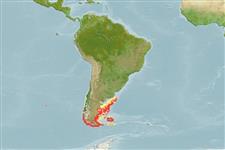Common names from other countries
Classification / Names / Names
Noms communs | Synonymes | Catalog of Fishes (gen., sp.) | ITIS | CoL | WoRMS
Environment: milieu / climate zone / depth range / distribution range
Écologie
; profondeur 0 - 90 m (Ref. 83435). Temperate; 38°S - 56°S, 74°E - 57°E (Ref. 83435)
Southeast Pacific and Southwest Atlantic: Chile, Falkland and Argentina.
Length at first maturity / Taille / Poids / Âge
Maturity: Lm ? range ? - ? cm Max length : 2.4 cm DL mâle / non sexé; (Ref. 83435)
It is found on rocky substrates, on or beneath rocks, in rock crevices, rocky walls and tide pools, and on brown algae (Ref. 87801), like forests of Macrocystis pyrifera (Ref. 92889).
Life cycle and mating behavior
Maturité | Reproduction | Frai | Œufs | Fécondité | Larves
Egg masses are composed of 4 to 19 egg capsules, containing 1 to 5 embryos developing within each capsule and emerges as crawling juveniles. Egg capsules are attached to a substrate.
Rosenberg, G. 2009. (Ref. 83435)
Statut dans la liste rouge de l'IUCN (Ref. 130435)
statut CITES (Ref. 108899)
Not Evaluated
Not Evaluated
Utilisations par l'homme
| FishSource |
Outils
Plus d'informations
Taille/Âge
Croissance
Longueur-poids
Longueur-longueur
Morphologie
Larves
Abondance
Sources Internet
Estimates based on models
Preferred temperature
(Ref.
115969): 6.3 - 13.1, mean 8.6 (based on 194 cells).
Catégorie de prix
Unknown.
